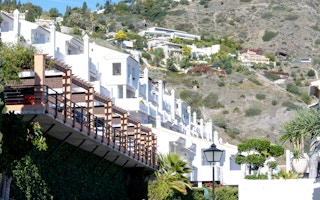Engineering reflectivity can be a way to protect human safety during dangerous heatwaves: in the baking rural regions, put off ploughing those freshly-harvested wheat fields. And in the sweltering cities, paint the houses white, fit shiny roofs and plant pale-leafed tree species.
In a word, increase reflectivity. Bounce more sunlight back into space to save lives, tempers and energy costs. It would, in effect, be local geoengineering, but without the unimaginable costs of spraying aerosols into the stratosphere, or placing solar reflectors in orbit; and without unwelcome side effects.
And it is based on the simple observation that a harvested wheat field is brighter than ploughed croplands, and that reflective roofs are less likely to absorb sunlight than dark tiles or slates.
“These measures could help to lower extreme temperatures in agricultural regions and densely populated areas by up to two to three degrees Celsius,” said Sonia Seneviratne, professor of land-climate dynamics at ETH Zurich, the Swiss federal institute of technology.
And her co-author Andy Pitman, of the University of New South Wales, who directs the Australian research council’s Centre of Excellence for Climate Extremes, said: “Extreme temperatures are where human and natural systems are most vulnerable. Changing the radiative properties of land helps address this issue with fewer side effects.
“This research suggests that by taking the regional approach, at least in temperate zones, policy and investment decisions can be pragmatically and affordably focused on areas of greatest need.”
“
Even this climate technique is no silver bullet; it’s just one potential tool among several others in the battle against climate change.
Sonia Seneviratne, professor of land-climate dynamics, ETH Zurich
The Swiss and Australian scientists report in the journal Nature Geoscience that they worked with computer models to simulate changes in the albedo of the land and the cities: albedo is the climate scientist’s word for the reflectivity of ocean, ice, desert or forest.
What the researchers found was that the higher the temperatures, the stronger the effect of enhanced albedo, or reflectivity.
Growing problem
And the big heat is on the way. Researchers have repeatedly confirmed that heat extremes pose increasing threats, especially to the megacities, urban centres with more than 10 million people.
They have also confirmed that such extremes of heat can be lethal, especially when matched with rising humidity.
Cities in any case are more at hazard, because of the notorious urban heat island effect. Greater investment in air conditioning plant is not the answer, because it could only increase energy demand driven by fossil fuel combustion and thus raise urban temperatures even higher and increase long-term global warming even more.
So there has been more emphasis on natural responses, such as greater investment in the “urban forest” of park, garden and avenue trees to keep the urban population a little cooler.
Reducing extremes
The latest study found that large scale alteration of rural and urban albedo had no significant effect on average temperatures, and made hardly any difference to rainfall in Europe and North America. But as the thermometer soared, so did the effect: it did significantly reduce the extremes of heat.
In Asia, this form of what might be called grassroots geoengineering may not suit: monsoon rainfall fell in the simulation, and the monsoons are crucial to the economies of China and India.
“Regional radiation management can be effective, but even here we have to consider any potential effects on food production, biodiversity, CO2 absorption, recreation areas and much more,” said Professor Seneviratne.
“Even this climate technique is no silver bullet; it’s just one potential tool among several others in the battle against climate change.”
This story was published with permission from Climate News Network.

















